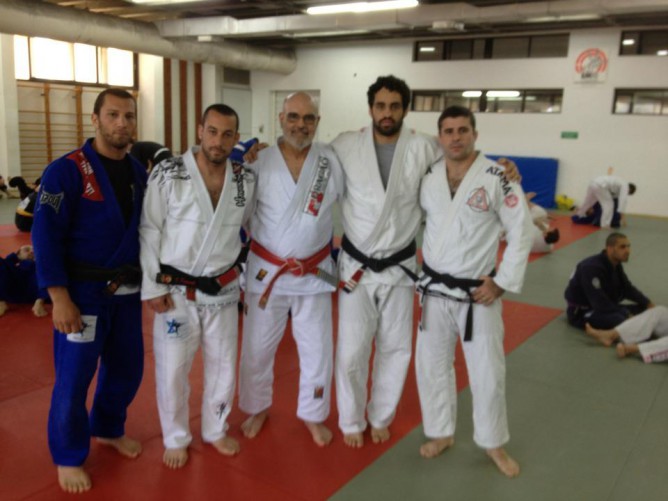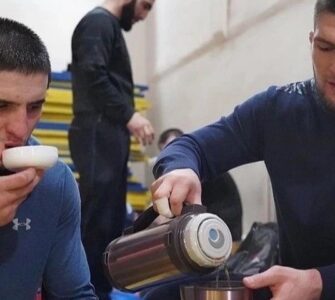Gabriel Kitober has been training BJJ for 20 years, before this he did Judo. In this time he has trained under so of BJJ’s biggest masters: Rickson Gracie, Helio Gracie, Osvaldo Alves, Royler Gracie, Carlos Gracie Jr etc..His BJJ journey brought him to the USA, England and Israel where he was responsible for the ground work of the Israel national Judo team. Gabriel is a 6 times Brazilian national champion, 2 times silver in worlds absolute, world champion FILA grapling. Find out more about this very interesting BJJ player:
Gabriel, you have had the chance to learn from Jiu-Jitsu ‘s greatest masters such as GM Helio Gracie, Osvaldo Alves, Rickson Gracie, Carlinhos Gracie and Royler Gracie. Can you tell us about each ine’s teaching style and maybe share some stories?
Yes. Because I have lived in Rio de Janeiro Brazil, I had the opportunity to learn from all these great masters of Jiu –Jitsu you mentioned. And they are definitely great masters in many different ways. My first contact with Jiu -Jitsu was through master Carlos Gracie Jr. And at that time, his school (Gracie Barra) had one of the best team I have ever seen in my life and I was very fortunate to have the chance to be around them. It was a team made up of 50 high-level athletes including: Gordo, Renzo Gracie, Nino, Draculino , Ryan Gracie , Gracie Ralf , Marcio Feitosa , Roleta, Cachorrao, Cachorrinho, Romeu Cardoso, and many others. And Carlos Gracie Jr. , has always being a great leader to these great athletes. He did such an awesome job keeping his team always very positive, motivated and united.

Then, I had the opportunity to train with Royler Gracie, who, I think, was one of the major competitors in the history of Jiu-Jitsu. I remember that when I trained with him; he was on top of his BJJ career and I was very impressed with his game and routine. He was an athlete who could train at a very high-level and teach several classes for adults, kids and give privates classes. I can tell you that Royler Gracie has many characteristics but there are three that I admire very much; he pays very close attention to detail, has a very positive attitude and is very technical. He is always in a good mood, which is a characteristic of all Gracies that I have met in my life. At Gracie-Humaita’s school, I had a unique opportunity that a few of my BJJ generation have had! I had the unforgettable opportunity to get to know Master Helio Gracie. I was honored in participating in some of his private lessons. Master Helio was a very special man. He had the gift of making people who were close to him to feel different about themselves, in a good way. I remember that his BJJ classes were always very technical and had a focus on self-defense skills and fundamental techniques of Jiu-Jitsu. He paid very close attention to detail; I guess Royler Gracie got this from him. At that time, Master Helio Gracie was more than 80 years and he used to travel from the mountains to the city to teach BJJ. His energy and vitality was something that impressed everyone.
With master Osvaldo Alves was a different experience; it was a very tough and dynamic practice. His Jiu-Jitsu was different from what I had seen it before. We trained together for more than 10 years, every single day! We used to do our conditioning training at the beach at 7:00am, followed by 1000 takedown drills, lots of BJJ drills. And at night, we used to have very good sparring sessions. It was definitely a good time!!!
GM Osvaldo Alves is a great judoka and Jiu-Jiteiro. How much stand up game was incorporated in his teaching?
Osvaldo knows very well how to adapt the standing technique for Jiu-Jitsu. However, what impressed me the most was how he has incorporated judo techniques into Jiu-Jitsu. For example, he took “the standing Ultich Komi Judo” down to the ground. He established a series of drills with the same concept of speed, explosion and dynamism of the judo and applied into Jiu-Jitsu. Thus, Osvaldo Alves’s BJJ style is very aggressive, fast paced and dynamic attacks.
How did you end up teaching BJJ in Israel? Can you tell us more about the BJJ and Judo scene there?
In 2010, I went to visit my family who lives in Israel and to promote Brazilian Jiu-Jitsu in the most positive way possible. I opened my own gym, which still exists until now. And then, I was invited to be part of the team of coaches of the Israel National Judo Team. The Jiu-Jitsu in Israel is going very well; I believe that in 5 to 10 years we will have names from Israel on the podium of the World BJJ Championships.
In Israel, Judo is a very traditional sport. Although Israel is considered a very new country, it has already Olympic medal winners, World champions and European champions. Israel has welcomed immigrants from several regions; and just to name a few: Eastern Europe (Russia, Georgia, Ukraine, etc.), France and its former colonies and South America which has a Japanese influence. Due to this diversity, Israel developed a unique style and I believe this is the reason why Israel has one of the best judokas in the world. To make their judo complete, we worked very hard on ground fighting skills, that was the component that they were lacking. After all the hard work and time we have put it, we could see great results. Israel’s Olympic team has some of favorites to win a medal. The team’s current coach, Oren Smadja, an Olympic and world medalist, and perhaps one of the most technical judokas I have ever meet in my life, has been doing a great job with his team. I do believe they have a huge chance to get great results in the Olympics Games.

Gabriel in Israel
Can you tell us more about your academy in Atlanta and your plans in 2015?
I am currently in Atlanta, assisting some of the UFC athletes and regulars students from the X3 Sports Gym to improve their BJJ and MMA skills. It is a great and very well equipped gym, having all that I need for my training sessions. And, I am surrounded by great names in martial arts including: Rodrigo Artilheiro, Tony Tucci, Roberto Traven and Mike Littrel. Also, as soon as I get closer to the competition season, I will begin my training camp with GF team.
My goal for 2015 is to compete at some of the “Open IBJJF Jiu-Jitsu Championship” which I see as a way to prepare myself and be 100% ready for big competitions such as Pan American and Worlds Jiu-Jitsu championships. In 2015, I will give a little more emphasis training Jiu-Jitsu with GI, and also planning on participating on some wrestling and judo’s championships in the USA
What is your opinion of the current state of competition Bjj and the evolution of the game with all the new guards and stategic styles?
I really like this game. It is a very smart and technical game, full of leverages, but I don’t play it that much. An athlete should use the game he feels more comfortable and confident with, but needs to be familiar with this game and know how to play this style. And probably most importantly, he should be able to defend himself effectively from this game, because you never know who will fight with. You might be in a situation in which your opponent plays this game very well, and if you don’t know you will be a complicated situation.
You have a strong judo and wrestling background. Do you think that it’s possible to be a black belt bjj world champ without a solid takedown game ( for example Leandro Lo or Miyao bros)
Sure, especially because the rule allows you to pull guard without getting punished. If you have a great and strong guard and feel comfortable in all the possibilities that it offers you, you don’t need that much to have a solid takedown game. On the other hand, there is a necessity for a solid takedowns game if you are a top player without a good bottom game.
In your opinion, for BJJ, is it better to cross train in judo, wrestling or sambo to improve takedowns?
For the GI BJJ, the former judo (which the rules allow to grab the legs) and sambo are much more efficient. But for the NO GI, wrestling is undoubtedly more efficient because of the grips. However, there are ways that you can adapt wrestling to GI and judo to NO GI always taking into consideration BJJ’s own specificities. For example, when you are training wrestling to improve your game for BJJ competitions, takedowns and defense against takedowns should be emphasized. You should incorporate takedowns from wrestling to your BJJ game. If you are training judo, you should have an emphasis on training Komi Kata (“fight grips”) and takedowns that you don’t allow your back to be exposed.
if you want to thank somebody or sponsors, feel free.
I would like to thank my kimono sponsor Grips and my family, all X3 Sports partners, Rodrigo Artilheiro, Roberto Traven, Julio Cesar, Lucio Lagarto, and my conditioning coach Angel Aldama.

















